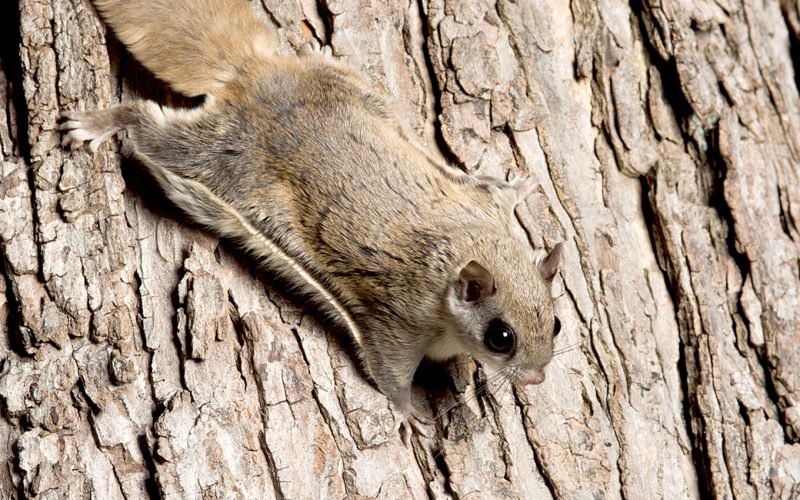
Courtesy Photo | Even though they’re very common in Northwest Arkansas, Flying Squirrels are hardly ever seen because they’re nocturnal and the size of chipmunks, with disproportionately large black eyes that make them adorable.
It’s a bat! No, it’s a bird!
No, it’s actually a southern flying squirrel, Glaucomys volans, often mistaken as a bat or a bird by homeowners who are unknowingly leasing their homes to these elusive critters. Even though they’re very common in Northwest Arkansas, they are hardly ever seen because they’re nocturnal and the size of chipmunks, with disproportionately large black eyes that make them adorable. Northern flying squirrels are slightly larger but not much easier to find in the wild. Our local “flyers,” as they’re fondly called, are almost invisible bundles of cuteness, yet are hardy enough to have expanded their range well into the northern states.
Flying squirrels don’t actually fly. They glide by extending furred membranes between their forelegs and hind legs, creating a type of parachute effect. They typically glide about 30 feet but can go as far as 270 feet from a high perch. Flyers spend more of their time in the treetops than the larger fox squirrels which are present in patches throughout Northwest Arkansas, so finding a flyer on the ground is lucky. They often enjoy truffle hunting, which brings them down to earth momentarily during the right seasons.
Southern flying squirrels are omnivores, and eat a varied diet of the expected nuts, seeds, fruits, sugar maple sap, blossoms, fungi, and tree bark, but also carrion, bird eggs, nestlings, and suet. They especially like black oil sunflower seeds, but beware allowing them to have too much in their diet because they may lose their fur. They are on the menu for pet cats and feral cats alike, as well as bobcats, foxes, owls, hawks, raccoons and weasels.
There aren’t many studies of southern flying squirrel family life. We do know they have between two and seven young probably twice annually, and live up to 10 years (but most wild flying squirrels don’t live longer than five years). They make nests out of feathers, moss, lichens, and shredded tree bark. Females usually have a one acre territory, males one and a half acres, but this varies. There can be around four flying squirrels per acre in some places.
The best way to spot one is to live with one, typically because they’re nesting in your home or outbuilding. Birders occasionally find them taking up residence over the winter, sometimes in surprising numbers, in bluebird nest boxes. Groups of squirrels huddling together in a tree cavity or nest box can raise the temperature inside the hole, sharing body heat and increasing their chances for survival during cold nights.
Most people don’t want them in their buildings, though. They can cause problems with chewing and noisy behavior, especially because they’re most active at night. Hearing activity during the daytime usually indicates the presence of our more visible neighbor, the grey squirrel. If you need help removing some flying squirrels or other wildlife, they can be humanely trapped and released by our local Wildlife Damage Control services. Contact Dan Taylor at 479-381-2222 for more information.
Amanda Bancroft is a writer, artist, and naturalist building an off-grid earthbag cottage for land conservation on Mt. Kessler. She and her husband Ryan blog about their adventures and offer a solar-hosted online educational center on how to make a difference with everyday choices at: www.RipplesBlog.org.










